
4.1.1 The linear model of QW-HFM
The QW-HFM module can solve the heat transfer equation (4.1-1) using an internally implemented FDTD algorithm. In this algorithm all the objects that take part in the analysis are discretised – or divided into a number of relatively small parts (or cells). The heat flow within such an object is simulated as a superposition of heat flows between neighbouring cells. This concept has been illustrated in Fig. 4.1.1-1. The heat Q is transferred between centres of the cells (marked with red spheres) where the temperature T is calculated. The parameters k, l, and m are cell indices.
Fig. 4.1.1-1 A discretised object and the heat flows between neighbouring cells.
In this approach the continuous heat flow equation (4.1-1) has to be modified so that it can be applied to discretised objects that consist of a finite number of cells. The discretised equation has the following form:
(BHM 4.1.1-1)
where Dt is the length of the FDTD time-step (smaller or equal to the QW-BHM time-step Dt), Vk,l,m is the volume of the current cell, while c and r are the specific heat and the density of the medium filling this cell. The symbol n stands for the time index. The parameters Nk, Sk, Ek, Wk, Uk and Dk are coefficients that describe the heat conductivity between the current cell and – respectively – the cell lying to the North, South, East, West, above and below. The values of those coefficients depend on the properties of the media that fill the cells as well as on the cells’ dimensions. Thus in the FDTD mode of operation with linear thermal model, all three media parameters: c, r and k need to be listed in media *pmo files. The values from the first row (at the lowest temperature listed in the file) are taken throughout the analysis.
The QW-HFM module reads the initial value of the temperature field from the *.hfe and simulates the process of heat transfer for period equal to the QW-BHM time-step Dt using equation (4.1.1-1) with boundary conditions specified by the user. The FDTD time step Dt is optimally chosen so that the algorithm is stable and the number of iterations is kept low. Refer to the next section, for the description of equations used by the QW-HFM module for modelling of phase-change problems, when changes of thermal media parameters may be quite drastic.
After the computations are completed the results are saved to the *.hfi file and the QW-HFM module quits letting the QW-BHM resume the operation and proceed with the simulation.